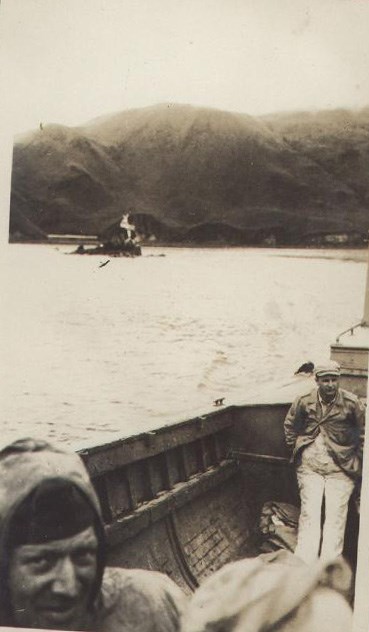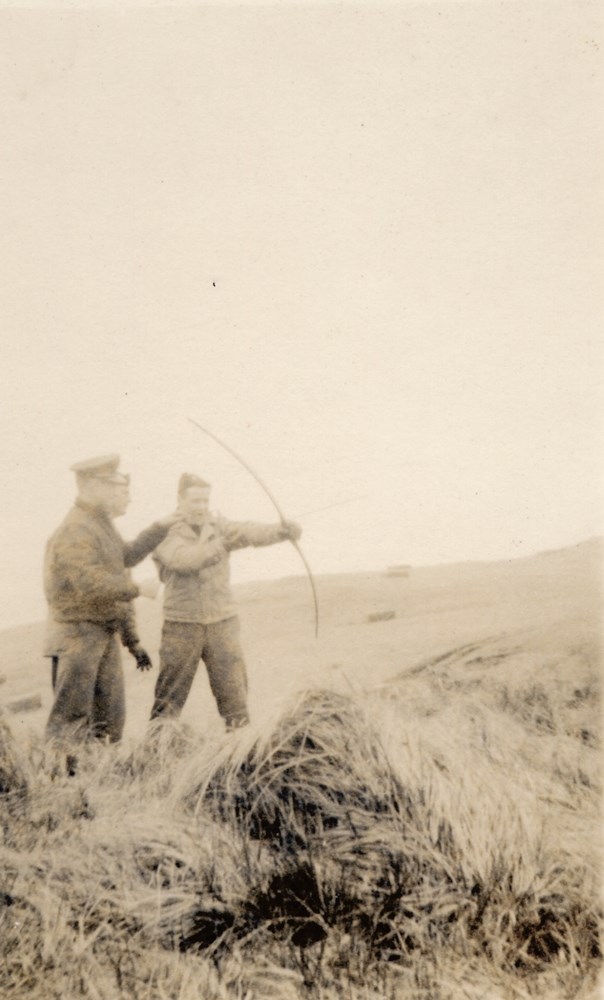Part of a series of articles titled 807th Battalion History.
Article
807th Battalion History, part 1: Activation and more
Activation
1. General.
Prior to the entry of the United States into the present war the need for specialized aviation engineers to provide air-fields and operating facilities for the Air Forces was recognized. Several Aviation Engineer Regiments and numerous separate companies were activated in 1940 and 1941, among them the 807th Engineer Company (Aviation).
2. Original Company.
The above separate company was constituted by General order No. 16, Headquarters Ninth Corps Area, dated 8 March 1941, and activated by Special Order No. 16, Headquarters Yakutat Landing Field, Yakutat, Alaska, dated 24 March 1941. Original personnel came from Company B, 28th Engineers (Aviation) by transfer consisting of 154 enlisted men and 4 officers.
Yakutat Landing Field
1. Training of Original Company.
Officers and enlisted men were Corps of Engineers personnel but had not been trained as a unit. The capabilities and former training had to be welded into an efficient team while actively engaged in an airfield construction at Yakutat, Alaska on the shores of the Gulf of Alaska.
2. Working Conditions and Equipment.
Yakutat village consisted largely of native Alaskan Indians and offered only isolation, heavy rainfall, and an almost total lack of recreational or entertainment facilities for the men. Travel was by water and small aircraft operated by Alaskan "Bush Pilots."
The company constructed a dock, roads, base camp, cleared and graded sites for 2 runways 150 x 7500 feet. Cold rains and lack of waterproof clothing made all outdoor tasks disagreeable during the early stages. Civilian construction forces followed up the ground work of the company and carried it forward.

Photo courtesy of Neil Fugate
Chernofski Harbor, Unalaska Island, Aleutians
1. Movement.
Upon declaration of war by the United States 7 December 1941 all leaves and furloughs were cancelled and orders issued for immediate movement of the Company to the Aleutian Islands. An advance detachment of 2 officers and 62 enlisted men departed from Yakutat 29 December 1941 with destination Umnak Island some seventy miles west of U.S. Naval base at Dutch Harbor. Great secrecy veiled the movement as the mission was to construct a secret airfield west of Dutch Harbor for land based planes in anticipation of an attack by Japanese Naval units against Dutch Harbor. Early supplies destined for Umnak were marked for delivery to a fictitious fish canning concern.
2. Arrival at Chernofski Harbor.
Advance detachment arrived at Chernofski Harbor on the northwest tip of Unalaska Island 18 February 1942. This was the nearest protected anchorage to the site of the proposed airfield at the southeast tip of Umnak Island, twleve miles distance across Umnak Channel. Chernofski Harbor was only a sheltered body of water without channel markers, anchorage bouys, or docks. A few abandoned cabins were the only indication of former habitation.
Due to changes in shipping schedules the primary mission of the detachment was changed to unloading ships and transporting troops and supplies across the treacherous Umnak Channel to Umnak Island. One small tugboat and three open fish scows of 50 tons capacity were the only floating plant for lighterage and transport. Dock material was unloaded and unloading piers for barges constructed and a temporary camp set up on the barren beaches. 700 Infantrymen arrived during these operation and had to be transported across the channel to Umnak Island by this inadequate floating plant, during the dead of winter when storms were frequent and severe and the surf on the Umnak beach treacherous even during breaks between storms. All this was accomplished by the engineer troops without former experience with boats or water operations. One civilian tugboat operator was the only trained man in the operation. On 20 February the remainder of the Company arrived at Chernofski Harbor.

Photo courtesy of Charles Donovan
Umnak Island
1. Preliminary Work.
The original detachment constructed pioneer roads from the beaches on Umnak Island to enable Infantry and other arms and services to reach their areas. A lone tractor became hopelessly mired in the soft tundra during road construction and required several days to dig out. The sodden ground permitted transport only by tractor during the initial stages when steel runway mat for construction of a temporary airfield was hauled to the site from the beaches. Operators became lost on the treeless wastes on several occasions, in blinding snowstorms whipped by arctic gales, and spent the night under such shelter as they could improvise.
2. Temporary Airfield.
Hummocks of open tundra on the airfield site were levelled and the tons of steel landing mat laid on the flattened area to provide a landing strip 100 feet by 500 feet long. Weather continued severe but on 31 March 1942 the field was ready for landings and planes of all types began to arrive. This secret field has been credited with turning the Japanese fleet during the attack on Dutch Harbor 3 June 1942. Land based B-26 Marauders scattered the carriers of the enemy with torpedo attacks from this westernmost base of the U.S. in coordiation with Navy Patrol planes.
3. Activation of the Battalion.
On 1 May 1942 the 807th Engineer Battalion Aviation (Sep) was activated at Fort Glenn, Umnak Island, Alaska, by General Order No. 8 of that Headquarters. General Order No. 36, 1942, Headquarters Alaska Defense Command designated 807th Engineers Company (Aviation) as "A" Company of the newly activated battalion.
On 24 May filler replacements numbering 534 arrived from the United States. These selective service men had received basic training but unit training was entirely lacking. The welding of newly arrived officers and enlisted men into an effective team was accomplished on-the-job under an urgent and heavy construction program. Roads, water lines, fuel tanks, airfield construction was carried on while conducting this training of mechanics, equipment operators, truck drivers, and innumerable other specialists required in an engineer unit. Impending operations as part of a task force added to the problems of officiers and men and taxed their energies to the limit. Company "B" was ordered to depart without delay to construct and emergency landing field and facilities at Port Heiden on the Alaska Peninsula before much training could be given or absorbed.
Port Heiden
1. Movement.
Advance detachment of 1 officer and 46 enlisted men of Company "B" left Umnak Island for Port Heiden on 19 June 1942 aboard small power barges capable of carrying 100 tons of cargo. A small tug followed with a few trucks and earthmoving equipment on an open scow. When the remainder of the company lef Umnak on 4 July it was necessary to include 51 men of Headquarters Company thereby further reducing the effectiveness of the battalion to carry on the vital work at Umnak and future operations.
2. Mission.
Work accomplished at Port Heiden again included construction of harbor facilities to unload supplies, access roads, beach and base camps. Runway sites were 3 miles from the beach. Earth movement started 23 July and an O-49 plane landed 11 August. One runway 400 x 5000 feet was completed before freezing temperatures halted airfield work in December. With the assistance of Infantry garrison troops the following were constructed: 206 Quonset huts, 7 mess halls, 6 Cowin huts, radio station, fuel tanks, and a temporary electric distribution system. An emergency airbase having been established, the bulk of the company and detachment left 19 December 1942 to join the battalion which had meanwhile moved on to Adak Island with the task force. One officer and 50 enlisted men remained to maintain the facilities and airfield and did not join the parent organization until 8 months later.
Last updated: February 20, 2021
